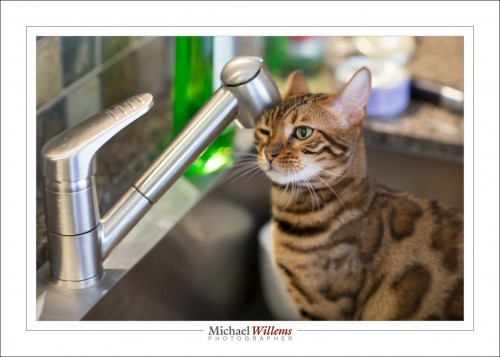Look at Mau the cat, who is pretending to not notice me:
I used my 85mm f/1.2 lens on the 1Dx body. The settings were 1/60 sec at f/2, 800 ISO.
Let’s think about that for a minute. 1/60 sec is about the slowest speed I can hand-hold: any slower and I would shake; and the cat would move visibly also. So that’s a given.
800 ISO is nice. Much more, and I start getting visible grain, certainly on cheaper cameras.
So unless I want to use a flash, f/2 in my kitchen is what I need.
Now… imagine I had a consumer lens,. like the 17-85 f/3.5–5.6. The latter designation means that when I zoom out I can get as low as f/3.5, but when I zoom in I cannot go any lower than f/5.6.
If I used this lens, I would have to go to a much higher ISO. To keep the same exposure, if I want to keep the same shutter speed, I would have to change ISO as follows:
- At f/2 I need ISO800
- At f/2.8 I needISO 1600
- At f/4 I needISO 3200
- At f/5.6 I needISO 6400
So with the cheaper “consumer” lens zoomed in, I need to go to 6400 ISO. Which would, especially on smaller cameras, give me a lot of grain; a bad quality picture, in other words.
So the more expensive, “faster”, lens gives me a huge benefit here. One not to be scoffed at, which is why we like prime lenses. Which are not all expensive: you can get a 50mm f/1.8 lens for just over $100.
Which I hope you have done!

